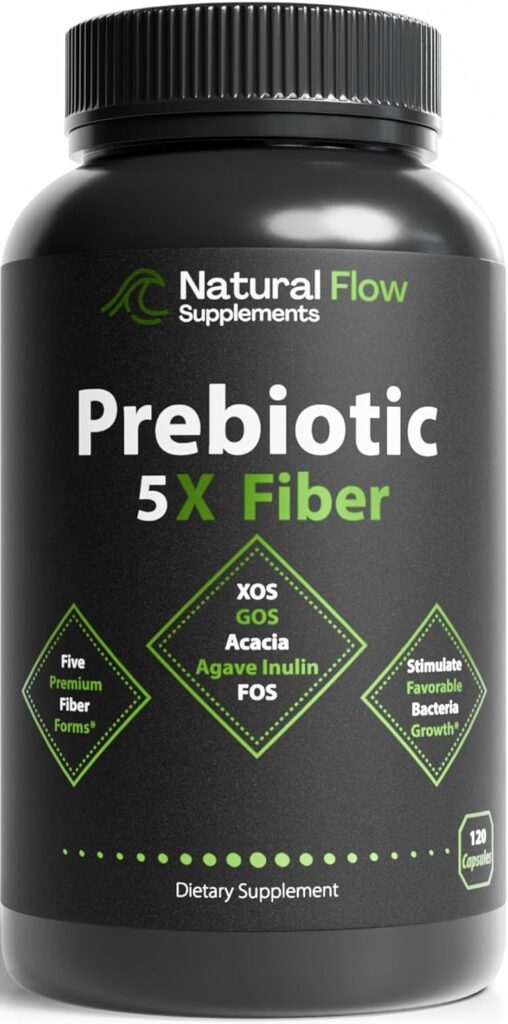If you’ve ever felt your stomach rumble, bloated, or full of uncomfortable gas, you know how distracting and uncomfortable a gassy gut can be.
While occasional gas is normal, persistent gassiness can interfere with daily life, affect your mood, and even impact your confidence.
Fortunately, there are natural ways to support digestion, reduce gas, and restore comfort to your gut.
In this post, we will explore 5 ways to ease a gassy gut, starting with its causes.
Let’s dive in!
What Causes a Gassy Gut?
A gassy gut often results from imbalances in your digestive system.
Eating too quickly, consuming high-FODMAP foods, or a lack of fiber can contribute to excess gas.
Additionally, an imbalance in gut bacteria: too many gas-producing microbes and not enough beneficial bacteria, can create bloating and discomfort.
Stress, dehydration, and certain medications may also slow digestion, causing gas to build up and leading to discomfort.
5 Ways to Ease a Gassy Gut
1. Prebiotic Fiber Capsules
Prebiotic fiber is a type of soluble fiber that acts as food for the beneficial bacteria in your gut.
By nourishing these “good” bacteria, prebiotics help create a balanced gut microbiome, which can improve digestion, reduce gas, and support overall gut health.
Out of all of the prebiotic fiber supplements I’ve tried, Natural Flow’s 5X Prebiotic Fiber is my personal favorite.
Natural Flow’s Prebiotic Fiber combines XOS, GOS, FOS, acacia fiber, and agave inulin to help nourish gut flora, reducing gas while improving nutrient absorption.
By promoting a healthier microbiome, these capsules can ease the discomfort of a gassy gut, making your digestion smoother and more efficient.
Simply take 2 capsules per day and you’re good to go!
2. Peppermint Tea or Capsules
Peppermint is well-known for its soothing effects on the digestive tract.
Drinking peppermint tea or taking peppermint oil capsules can relax the muscles of the intestines, reducing bloating and the sensation of trapped gas.
It also helps promote smoother digestion after meals, which can prevent gas from building up in the first place.
3. Stay Hydrated
Water is essential for healthy digestion and keeping your gut moving smoothly.
Drinking enough water helps prevent constipation, which can lead to gas buildup, and aids in breaking down food more efficiently.
Sipping water consistently throughout the day, rather than chugging large amounts at once, can help reduce bloating and keep your digestive system running optimally.
4. Mindful Eating
Eating slowly and chewing thoroughly can prevent swallowed air, a common cause of excess gas.
Additionally, being mindful of which foods trigger gas, such as beans, carbonated drinks, or cruciferous vegetables, can help you reduce discomfort without sacrificing nutrition.
5. Gentle Exercise and Movement
Light physical activity, like walking or stretching after meals, can help move gas through your digestive tract.
Gentle yoga poses, especially twists or stretches targeting the abdomen, can stimulate digestion and relieve bloating.
Regular movement keeps your digestive system active and helps reduce the likelihood of gas build-up.
Ease A Gassy Gut
A gassy gut can be uncomfortable, but with the right lifestyle adjustments and natural support, you can ease bloating, reduce gas, and restore digestive comfort.
Prebiotic fiber, hydration, peppermint, mindful eating, and gentle movement work together to support a healthy gut microbiome and smooth digestion.
By incorporating these strategies into your routine, you can feel lighter, more comfortable, and confident every day.
Thank you for reading!
Affiliate Disclosure
Some of the links on this site are affiliate links. This means that if you click on the link and purchase the item, we may receive an affiliate commission at no extra cost to you. I only recommend products or services that I believe will add value to my readers, however, some (not all) do pay us to be on this blog. Your support and theirs help keep this blog running, and I genuinely appreciate it.
Medical Disclaimer
The information provided on this website is for educational purposes only and is not intended as medical advice. This blog or the writer is not a licensed healthcare professional, and the content should not be used as a substitute for professional medical diagnosis, treatment, or advice. Always consult with your physician or other qualified healthcare provider before starting any new treatment or making any changes to your healthcare routine.
